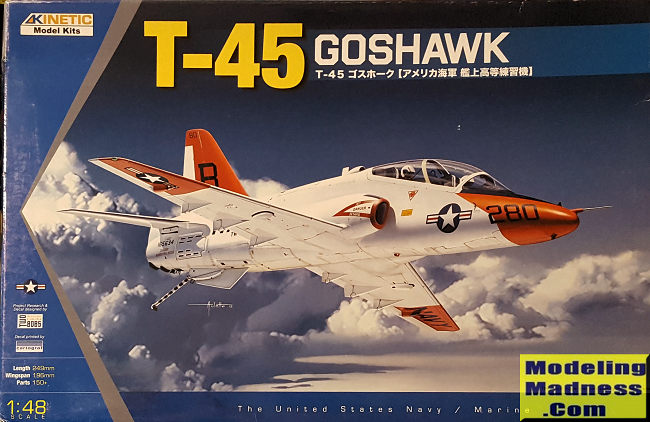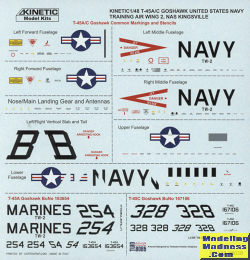
Kinetic 1/48 T-45 Goshawk
| KIT #: | K48038 |
| PRICE: | $35.00 |
| DECALS: | Two options |
| REVIEWER: | Scott Van Aken |
| NOTES: | 2012 release |

| HISTORY |
The T-45 Goshawk has its origins in the mid-1970s, during which time the U.S. Navy formally commenced its search for a new jet trainer aircraft to serve as a single replacement for both its T-2 Buckeye and A-4 Skyhawk trainers. During 1978, the VTXTS advanced trainer program to meet this need was formally launched by the U.S. Navy. An Anglo-American team, comprising British aviation manufacturer British Aerospace (BAe) and American aircraft company McDonnell Douglas (MDC), decided to submit their proposal for a navalised version of the land-based BAE Systems Hawk trainer. Other manufacturers also submitted bids, such as a rival team of French aircraft company Dassault Aviation, German manufacturer Dornier and American aerospace company Lockheed, who offered their Alpha Jet to fulfil the requirement.
The VTX-TS competition was not simply for the procurement of an aircraft in isolation; it comprised five core areas: the aircraft itself, capable flight simulators, matured academic training aids, integrated logistic support, and program management. For their proposal, MDC was the prime contractor and systems integrator, BAe functioned as the principal subcontractor and partner for the aircraft element, Rolls-Royce provided the Adour engine to power the aircraft, and Sperry is the principal subcontractor for the simulator system. During November 1981, the U.S. Navy announced that it had selected the Hawk as the winner of the VTX-TS competition. Reportedly, approximately 60 per cent of the work on the T-45 program was undertaken overseas in Britain. During September 1982, a Full Scale Engineering Development contract was awarded to the MDC team to fully develop and produce the proposed aircraft, which had been designated T-45 Goshawk. On 16 April 1988, the first T-45A Goshawk conducted its maiden flight.
221 aircraft were built and are divided into two training wings, each with about 100 aircraft. TW-1 is at Whiting Field in Corpus Christi and consists of VT-7 and VT-9. These planes have the A tail code. TW-2 is at NAS Kingsville in Texas and consists of VT-22 and VT-23. These aircraft have a B tail code. All T-45A aircraft have been upgraded to T-45C configuration. Back in 2017 there was a rash of hypoxia cases reported in not only the T-45 but also the F-18E/F, F-22 and F-35, all relating to faulty oxygen systems. All the planes were grounded and the issue resolved, but before that happened flight was resumed and all planes limited to no more than 10,000 feet so the system would not come into use. All non-fleet USN squadrons including those flying the T-45 are serviced by contractor maintenance.
| THE KIT |
 Typical
of modern kits, this one had engraved panel lines and engraved rivet detail. I
would equate the panel lines to being softer than what you find on
Hasegawa/Tamiya kits, but crisper than what you would find on older Airfix kits
like their Buccaneer. Instructions are well done with color information provided
throughout the build. These colors are referenced to the Vallejo line, though
you also get Mr Color, Italeri acrylic and Model Air paints. Instructions tell
you to paint the interior light ghost grey, but I think that is incorrect and
should be FS 36231, dark gull grey as that has been standard for USN aircraft
since the late 1950s.
Typical
of modern kits, this one had engraved panel lines and engraved rivet detail. I
would equate the panel lines to being softer than what you find on
Hasegawa/Tamiya kits, but crisper than what you would find on older Airfix kits
like their Buccaneer. Instructions are well done with color information provided
throughout the build. These colors are referenced to the Vallejo line, though
you also get Mr Color, Italeri acrylic and Model Air paints. Instructions tell
you to paint the interior light ghost grey, but I think that is incorrect and
should be FS 36231, dark gull grey as that has been standard for USN aircraft
since the late 1950s.
This kit consists of four grey and one clear sprue. There are a lot of parts included with this, as is apparently the norm for Kinetic. Options provided are instrument panels for the T-45A or T-45C, raised or lowered landing gear, open or closed canopy, raised or lowered flaps and a centerline pod. A note on the flaps, it is more often seen with these deployed on the ground than raised, though either is fine.
You get a nicely appointed cockpit and you do have to build
up both the nose gear well and main gear well out of sections, but that does
make molding the kit easier. As with every Kinetic jet kit I've built, you get a
full intake and exhaust trunking. This feature generally makes sm ooth
instillation a tad difficult so one needs to take their time. You will need nose
weight, but the instructions provide no guidance in that area. There is room for
perhaps 5-10 grams in there so I'd fill it as much as I could.
ooth
instillation a tad difficult so one needs to take their time. You will need nose
weight, but the instructions provide no guidance in that area. There is room for
perhaps 5-10 grams in there so I'd fill it as much as I could.
You get decals for two planes, both with TW-2. One is a T-45A as shown on the box art, while the other is a T-45C. Both are white and international orange. Decals are nicely printed, and if you don't like the kit schemes, there are aftermarket ones available.
| CONCLUSIONS |
This looks to be a very nice kit and while the detailing may be a bit much for some, it does not look all that bad to me. It should make a very nice model and one that will look great on your shelf. I know it will make a nice addition to my trainer collection. One further note is that the box is a flimsy end opening type. I don't like this type at all as it just invites damage. I ordered mine from an individual and though the kit was still sealed, he sent it in one of those free USPS priority boxes. End result is that the kit and box were smashed flat during delivery. If you sell kits, do your buyer a favor and get a proper corrugated cardboard box.
| REFERENCES |
https://en.wikipedia.org/wiki/McDonnell_Douglas_T-45_Goshawk
April 2021
Copyright ModelingMadness.com. All rights reserved. No reproduction without
express permission. If you would like your product reviewed fairly and fairly quickly, please
contact
me or see other details in the Note to
Contributors.